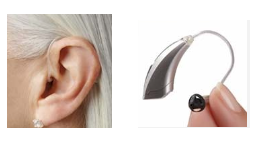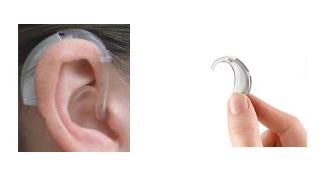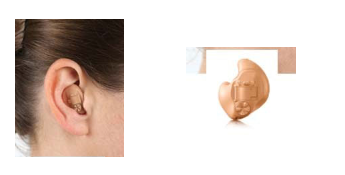Knowledge
1. How to wear a hearing aid?
BTE hearing aids
1)After confirming that the hearing aid is turned on, choose the appropriate eardrum head, and connect the eardrum head to the sound tube
2)Place the hearing aid on the back of the ear
3)The thumb and index finger hold the part of the hearing aid duct, put the front end of the hearing aid into the ear, so that the hearing aid is close to the ear canal
4)Make small adjustments to your hearing aids until you feel comfortable.
Inner ear hearing aids
1)After confirming that the hearing aid is turned on, select the appropriate eardrum head and put the eardrum head on the outlet of the hearing aid;
2)Place the hearing aid in the ear canal, adjust the position of the hearing aid, turn the patterned side of the hearing aid toward you, hold the hearing aid between your thumb and index finger, place the front end of the hearing aid into the ear canal, and push it in slowly, until the hearing aid is close to the ear canal and feels comfortable.
2. How to do the daily cleaning and maintenance?
1) Use the cleaning brush in the package of the hearing aid to remove the wax or other small particles around the ear canal, the volume knob and the battery compartment. Then gently wipe the hearing aid with a soft cloth.
2)Do not use a solvent, cleaning fluid, or oil to clean your hearing aid.
3)When hearing aids are not in use, turn the switch off open the battery valve, and put the hearing aids in a dry place, which can reduce the wear and tear of hearing aids.
3. Cleaning and maintenance of in-ear hearing aids?
1) The hearing care professional will provide you with special information about hearing aid cleaning and may recommend 1 special cleaning tool.
2)Water and solvents can damage electronic circuits. Clean the hearing aid with a dry soft cloth after each removal of the hearing aid.
3)Remove accumulated earwax daily. When using an earwax removal tool (such as a brush), the hearing aid should be cleaned from the bottom up. This prevents some earwax or dirt from entering the hearing aid.
4)If the hearing aid sound is weakened, it may be because the sound outlet or cerumen baffle is blocked by earwax. The cerumen baffle should be replaced or consulted by a hearing care specialist.
Note: In-ear hearing aids are particularly susceptible to damage from earwax, moisture or dirt. Because the electronic device and the chassis are integrated.
4. Hearing aid maintenance tips
A few simple precautions can ensure that your hearing aids provide you with trouble-free service for many years.
- Avoid knocking and collision with sharp objects
Sit on a soft surface (bed or sofa) to wear and remove the hearing aid.
- Keep hearing aids away from heat sources
Never place a hearing aid in a place where it may overheat. Avoid direct sunlight (at home or in a parked vehicle) and do not place it around the heater.
- Avoid moisture
Remove the hearing aid before showering, bathing or swimming. Do not put the hearing aid in the bathroom, it may be damaged by water vapor. Wipe the sweat inside and around the ear regularly. Moisture and condensed water droplets can damage the circuitry within the hearing aid. We recommend opening the battery compartment at night and using special tools available from a hearing care professional.
- Keep hearing aids out of reach of children and pets
Dogs do not like the sound of feedback (howling) but are attracted by the smell of the owner, often leading to chewing hearing aids. Hearing aid batteries can be dangerous if swallowed. If the battery is accidentally swallowed, seek medical attention immediately.
5. Tips for maintaining clean hearing aids
- Have a regular cleaning schedule. Plan to brush the microphone cover and wipe down the hearing aid every day. Complete a full cleaning once a week. It will be easier to turn this into a routine if you set a day and time for this process.
- Avoid exposure to moisture and humidity. This can damage the hearing aid’s internal electronics.
- Store your hearing aids properly. When you take your hearing aids out, try to store them in the same place each time. This could be in a jewelry box or nightstand, dresser or desk drawer. If they’re rechargeable, store them in your charging case. Do not store your hearing aid in the bathroom, as steam from the shower can affect the electronics.
- Remove the batteries at night. This will extend the life of the battery and air out the battery compartment.
- Avoid extreme heat or cold temperatures. This could lead to condensation, which can affect the hearing aid’s electronics.
- Use the proper cleaning supplies. Avoid using chemical solutions or wipes that are not intended for hearing aids.
- Do not insert anything into the microphone or receiver openings.
- Follow care instructions from your owner’s manual. Each hearing aid manufacturer may have specific instructions for the care of their hearing aids.
6. Styles of Hearing Aids
There are three main styles of hearing aids: Receiver-in-the-Canal (RIC), Behind-the-Ear (BTE), and In-the-Ear (ITE). Choosing which style of hearing aid is most suitable for you depends on your type of hearing loss and lifestyle needs.
Receiver-in-the-Canal Hearing Aids

Receiver-in-the-Canal (RIC) hearing aids are a discreet hearing aid option that sits behind the ear. The case behind the ear holds the hearing aid’s microphone(s), battery, and other components. A small, nearly invisible tube connects the case of the device to the receiver that sits inside the ear canal. RIC hearing aids come in a variety of colors and can treat nearly all levels of hearing loss.
Behind-the-Ear Hearing Aid

The Behind-the-Ear (BTE) hearing aids are similar to RIC hearing aids with the battery compartment, microphone, receiver and digital controls sitting behind the ear. Because some BTE models can house larger batteries for greater amplification and the speakers in BTE models are also located in the casing behind the ear, BTE models are typically larger than RIC models. When sound is captured by the BTE hearing aids, it travels into the wearers ear via a thin tube to a flexible ear dome or custom earmold. The casing that sits behind the ear can be purchased in various colors to match the wearer’s skin tone, hair color, or fashion choice. The BTE style is available in power levels suited for those with mild to profound hearing loss.
In-the-Ear Hearing Aids

In-the-Ear (ITE) hearing aids sit inside of the canal in a lightweight plastic shell. ITE hearing aids can be custom fit to the outer portion of the wearer’s ear with the use of an ear impression. There are also In-the-Canal (ITC) options that are more discreet, fitting inside the ear canal with a smaller portion visible in the outer ear. The Completely-in-the-Canal (CIC) option is even smaller and hardly visible to someone looking at the wearer’s ear, with a fully Invisible-in-the-Canal (IIC) also an option. ITE and ITC hearing aids are made for mild to severe hearing loss, while CIC and IIC are made for mild to moderate hearing loss.
